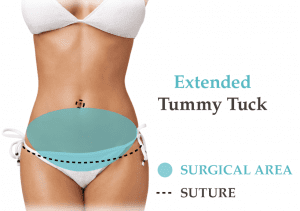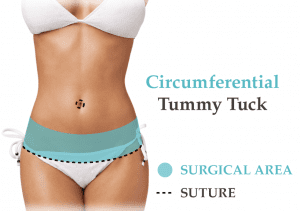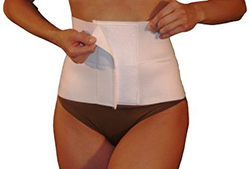Tummy Tuck
-
 Medically Reviewed by Charlie Chen, MD | Last updated 10/17/2023
Medically Reviewed by Charlie Chen, MD | Last updated 10/17/2023 - Overview
Overview
What is a tummy tuck?
A tummy tuck, also known as abdominoplasty, is a popular choice following pregnancy or weight loss. The overall goal of a tummy tuck is twofold: First is to remove excess abdominal skin and fat, and second is to repair stretched abdominal muscles by tightening them together. The result is an improved waistline and a flatter, more toned stomach.

Tummy Tuck Before & After
Cost of tummy tuck surgery
The total cost of tummy tuck surgery can range from $4,500 to $15,000. The following provides an general overview of the costs for different types of tummy tuck procedures:
- Mini Tummy Tuck Focuses on the lower abdomen and is less extensive than a full tummy tuck. The average cost typically ranges from $4,500 to $8,000.
- Standard Tummy Tuck: Also known as a full tummy tuck, this procedure addresses both the upper and lower abdomen, including muscle repair. The average cost typically ranges from $6,000 to $12,000.
- Extended Tummy Tuck: This type of tummy tuck is performed on patients who require significant skin and fat removal, usually due to massive weight loss. It involves an extended incision that may extend beyond the abdomen to the hips or lower back. The average cost typically ranges from $8,000 to $16,000.
- Circumferential Tummy Tuck: This extensive procedure treats the abdomen, hips, buttocks, and sometimes the lower back. It is commonly performed on patients with a large amount of excess skin after significant weight loss. The average cost typically ranges from $10,000 to $20,000 or more.
Factors affecting the cost of treatment
There are several factors that can affect the cost of your tummy tuck procedure. Here are some of the top factors that influence cost.
- Surgeon’s Fee: The experience and reputation of the plastic surgeon performing your tummy tuck procedure can affect the cost. Highly skilled and well-known surgeons often charge a premium for their services. The average surgeons fee is $6,154 according to the American Society of Plastic Surgeons (ASPS). experienced plastic surgeon who will help minimize risks associated with tummy tuck surgery.
- Anesthesia Fees: The administration of anesthesia involves the expertise of an anesthesiologist. The type of anesthesia used, the duration of the procedure, and the qualifications of the anesthesia provider influence the anesthesia fees. General anesthesia is typically more expensive than local anesthesia with sedation.
- Surgical Facility: The surgical facility where your tummy tuck is being performed may impact the cost. These fees cover the usage of the operating room and other associated services. To ensure a safe experience, check to see if your surgical facility is certified by the Accreditation Associations for Ambulatory Health Care (AAAHC).
- Location Matters: The cost of living and the average pricing for medical services in a particular area can affect the cost of your procedure. In general, urban areas tend to have higher procedure fees. If you want to get a rough idea of the prices for medical procedures in your local area, you can use the Healthcare Blue Book, which functions similarly to Kelley Blue Book for estimating car prices.
- Type of Tummy Tuck: The type of tummy tuck will impact cost. Full tummy tucks are typically more expensive then mini tummy tucks
- Pre and Postoperative Care: This includes consultations, medical tests, surgical garments, medications, and follow-up appointments.
- Additional Procedures: Your cost may be higher if you’re considering having other procedures along with your tummy tuck such as liposuction or thigh lift surgery.
- Insurance Coverage: In certain cases, your tummy tuck may be covered by insurance if it is deemed medically necessary. In these cases, insurance may cover a portion of the procedure. However, insurance coverage can vary and specific criteria must be met to qualify for coverage.
If you are considering tummy tuck surgery, setup a consultation with a board-certified plastic surgeon near you. This will allow you to discuss your aesthetic goals and obtain a better understanding of the specific costs involved.
Is the cost covered by insurance?
In general, a tummy tuck is considered a cosmetic procedure and is not covered by health insurance. Insurance companies typically classify tummy tucks as elective surgeries performed for aesthetic purposes rather than medical necessity.
However, there are some cases where a tummy tuck may be partially or fully covered by insurance if it is deemed medically necessary. This typically occurs when the excess skin or abdominal muscles are causing functional problems or medical conditions. For example, if the excess skin causes chronic rashes or infections that cannot be resolved through non-surgical means, or if the abdominal muscles are significantly weakened or separated (diastasis recti) and causing functional issues or pain.
In such cases, it may be possible to obtain coverage for the functional component of the procedure, such as muscle repair or hernia correction. However, coverage for the cosmetic component, such as excess skin removal is unlikely.
It is important to consult with your insurance provider and plastic surgeon to determine if any part of the procedure may be covered by insurance. Your surgeon can help provide documentation and supporting evidence to make a case for medical necessity.
Is a tummy tuck right for you?
Men and women can both be candidates for a tummy tuck. People who have lost significant amounts of weight often have loose, sagging skin and stubborn pockets of fat that do not respond to diet or exercise.
Tummy tucks are very popular among women who have recently gone through childbirth, since pregnancy can radically alter the physical appearance of the abdominal region. Tummy tuck surgery will tighten the abdominal muscles, which are generally loosened during pregnancy.
You may be a good candidate for a tummy tuck procedure if you are:
- In good overall health.
- At a stable weight and less than 30 pounds over your ideal weight.
- Have extra abdominal skin, abdominal muscle weakness, or both.
- Do not plan on becoming pregnant.
- Properly informed about the procedure and what to expect.
- A non-smoker
What to know beforehand
- A tummy tuck is not an effective weight loss treatment.
- The surgery will leave a small scar. Although a good surgeon can minimize scarring, you will have a small scar in the bikini area.
- Another pregnancy can affect your tummy tuck. It is best to wait until you’ve finished having children before undergoing this procedure or a full mommy makeover.
- Weight gain may negatively affect your surgery results. Substantial weight gain after a tummy tuck can cause skin stretching and reduced muscle firmness.
Types of tummy tucks
There are several types of tummy tuck procedures which to address the amount and location of access skin that needs to be removed. Your surgeon will choose the best option based on your unique cosmetic goals and desired outcome. The following are some of the different types of tummy tuck incisions that can be used during the procedure.
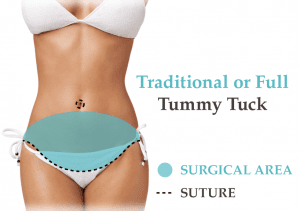
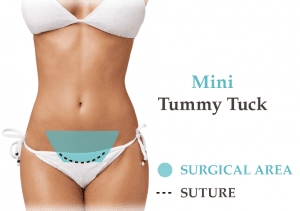
Extended tummy tuck: The extended technique is most effective for getting rid of the overall fat on your abdomen, flanks and back areas (“love handles”). Although it leaves a longer scar, a skilled surgeon will make sure that it can be hidden by most undergarments or bathing suits.
Circumferential tummy tuck: This method addresses everything the extended method does and more. It involves a surgical incision that extends completely around the waistline into the lower back and buttocks. Oftentimes, this approach is used for patients following massive weight loss or bariatric surgery.
Reverse tummy tuck: This method involves removing excess abdominal skin from the upper abdominal area. An ideal candidate for a reverse tummy tuck has a tight lower abdomen but excessive skin in the upper abdomen. An incision is made below the breasts, giving the surgeon access to the upper abdominal wall and allowing them to remove excess skin. In most cases, scars are hidden within the breast crease. This technique can be combined with other breast procedures, such as a breast augmentation using the same incision, for optimal results.
What happens during the procedure
The following provides a general overview of how a tummy tuck procedure is typically performed:
- Anesthesia: General anesthesia is used to ensure that you are asleep and feel no pain during the procedure.
- Incision: An incision is made on the lower abdomen which typically extends from one hip to the other just above the pubic area. The size of the incision can vary based on the extent of your surgery.
- Skin and Fat Removal: Next, the surgeon separates the skin from the underlying tissue and removes any excess skin and fat. In some cases, liposuction is used to help contour the abdominal area.
- Muscle Repair: The abdominal muscles are then tightened and sutured together. This helps create a firmer and more well-defined abdominal contour.
- Navel Repositioning: During a standard tummy tuck, the surgeon may reposition the belly button as the excess skin is pulled downward.
- Skin Redraping and Closure: The remaining skin is re-positioned and pulled tightly over the abdomen. Any surplus skin is trimmed away and the incisions are closed using sutures. In some cases, temporary drainage tubes may be placed beneath the skin to prevent fluid buildup.
- Bandages and Garments: The incision site is covered bandages and a compression garment is applied over the abdomen to reduce swelling and help contour the area.
Following the procedure, your plastic surgeon will provide you with instructions on post-operative care, including proper wound care, pain management, and any activity restrictions.
Recovery time
Each person who undergoes tummy tuck surgery will have a unique recovery experience. There are a number of factors that can influence recovery time, including age, type and extent of procedure, etc.
In general, most patients return to work after 2-3 weeks and resume strenuous exercise in about 6-8 weeks. By 3-6 months post-op, most patients are enjoying their permanent results.
When will you see results?
Although preliminary results are immediately visible after your tummy tuck, it will take 3-6 months to achieve final, stable results. It is important to follow your surgeon’s instructions for post-operative care to minimize healing time.
How long will your results last?
Results of a tummy tuck are permanent as long as a healthy weight is maintained. However, significant fluctuations in your weight will negatively affect the abdominal contouring that the tummy tuck provided.
Tips for choosing a plastic surgeon
It is important to carefully select your tummy tuck surgeon. The surgeon you choose can significantly impact your surgical outcome and overall satisfaction. Find a plastic surgeon with extensive experience in performing tummy tuck procedures. Also, make sure that they are board-certified and affiliated with one or more of the following organizations:
- The American Board of Plastic Surgery
- The American Society of Plastic Surgeons
- The Aesthetic Society
EnhanceMyself.com relies on sources such as professional medical organizations, government agencies, academic institutions, and peer-reviewed scientific journals to write it’s articles. Learn more about how we ensure our content is accurate, in-depth, and unbiased by reading our editorial guidelines.
*Medical Disclaimer: This website does not provide medical advice. Read more.

